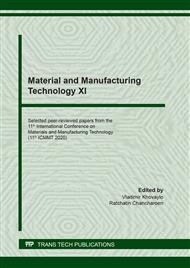p.27
p.34
p.40
p.49
p.55
p.61
p.67
p.73
p.83
Low-Cycle-Fatigue Properties of a 17-4 PH Stainless Steel Manufactured via Selective Laser Melting
Abstract:
In this paper, the static and low-cycle-fatigue (LCF) behavior of wrought samples of 17-4 PH stainless steel (SS) manufactured via Selective Laser Melting (SLM) are presented. On the one hand, several scholars have studied SLM materials and literature reports a huge amount of data as for the high-cycle-fatigue (HCF) behavior. On the other hand, few are the data available on the LCF behavior of those materials. The aim of the present research is to provide reliable data for an as-build 17-4 PH steel manufactured via SLM techniques. Only with quantitative data, indeed, it is possible to exploit all the advantages that this technology can offer. In this regard, both quasi-static (QS) and low-cycle-fatigue tests were performed on Additive Manufacturing (AM) cylindrical samples. Through QS tests, the constitutive low has been defined. Strain-controlled fatigue tests on an electromechanical machine were performed on 12 samples designed according to the ASTM standard. Tests were continued also after the stabilization was reached (needed for the cyclic curve described with the Ramberg-Osgood equation) to obtain also the fatigue (ε-N) curve. Results show that the material has a softening behavior. The Basquin-Coffin-Manson (BCM) parameters were tuned on the basis of the ε-N combinations after rupture.
Info:
Periodical:
Pages:
55-60
Citation:
Online since:
February 2021
Keywords:
Price:
Сopyright:
© 2021 Trans Tech Publications Ltd. All Rights Reserved
Share:
Citation:


